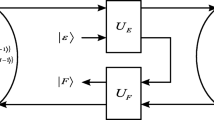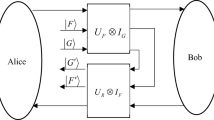Abstract
A universal and general quantum simultaneous secret distribution (QSSD) protocol is put forward based on the properties of the one-dimensional high-level cluster states, in which one sender dispatches different high-level classical secret messages to many users at the same time. Due to the idea of quantum dense coding, the sender can send different two-dit classical messages (two d-level classical numbers) to different receivers simultaneously by using a one-dimensional d-level cluster state, which means that the information capacity is up to the maximal. To estimate the security of quantum channels, a new eavesdropping check strategy is put forward. Meanwhile, a new attack model, the general individual attack is proposed and analyzed. It is shown that the new eavesdropping check strategy can effectively prevent the traditional attacks including the general individual attack. In addition, multiparty quantum secret report (MQSR, the same as quantum simultaneous secret submission (QSSS)) in which different users submit their different messages to one user simultaneously can be gotten if the QSSD protocol is changed a little.
Similar content being viewed by others
References
Gisin N, Ribordy G, Tittel W, Zbinden H. Quantum cryptography. Reviews of Modern Physics, 2002, 74(1): 145-195. https://doi.org/10.1103/RevModPhys.74.145.
Bennett C H, Brassard G. Quantum cryptography: Public key distribution and coin tossing. In Proc. IEEE International Conference on Computers, Systems & Signal Processing, December 1984, pp.175-179.
Boaron A, Boso G, Rusca D, Vulliez C, Autebert C, Caloz M, Perrenoud M, Gras G, Bussieres F, Li M J, Nolan D, Martin A, Zbinden H. Secure quantum key distribution over 421 km of optical fiber. Physical Review Letters, 2018, 121(19): Article No. 190502. https://doi.org/10.1103/Phys-RevLett.121.190502.
Cao W F, Zhen Y Z, Zheng Y L, Li L, Chen Z B, Liu N L, Chen K. One-sided measurement-device-independent quantum key distribution. Physical Review A, 2018, 97(1): Article No. 012313. https://doi.org/10.1103/physreva.97.012313.
Dellantonio L, Sorensen A S, Bacco D. High-dimensional measurement-device-independent quantum key distribution on two-dimensional subspaces. Physical Review A, 2018, 98(6): Article No. 062301. https://doi.org/10.1103/Phys-RevA.98.062301.
Huang A Q, Sun S H, Liu Z H, Makarov V. Quantum key distribution with distinguishable decoy states. Physical Review A, 2018, 98(1): Article No. 012330. https://doi.org/10.1103/PhysRevA.98.012330.
Islam N T, Lim C C W, Cahall C, Kim J, Gauthier D J. Securing quantum key distribution systems using fewer states. Physical Review A, 2018, 97(4): Article No. 042347. https://doi.org/10.1103/PhysRevA.97.042347.
Pivoluska M, Huber M, Malik M. Layered quantum key distribution. Physical Review A, 2018, 97(3): Article No. 032312. https://doi.org/10.1103/PhysRevA.97.032312.
Huang P, Huang J Z, Zhang Z S, Zeng G H. Quantum key distribution using basis encoding of Gaussian-modulated coherent states. Physical Review A, 2018, 97(4): Article No. 042311. https://doi.org/10.1103/PhysRevA.97.042311.
Lai H, Luo M X, Pieprzyk J, Zhang J, Pan L, Orgun M A. High-rate and high-capacity measurement-device-independent quantum key distribution with Fibonacci matrix coding in free space. Science China-Information Sciences, 2018, 61(6): Article No. 062501. https://doi.org/10.1007/s11432-017-9291-6.
Blakley G R. Safeguarding cryptographic keys. In Proc. the National Computer Conference, June 1979, pp.313-317. https://doi.org/10.1109/AFIPS.1979.98.
Shamir A. How to share a secret. Communications of the ACM, 1979, 22(11): 612-613. https://doi.org/10.1145/359168.359176.
Cleve R, Gottesman D, Lo H K. How to share a quantum secret. Physical Review Letters, 1999, 83(3): 648-651. https://doi.org/10.1103/PhysRevLett.83.648.
Hillery M, Bužek V, Berthiaume A. Quantum secret sharing. Physical Review A, 1999, 59(3): 1829-1834. https://doi.org/10.1103/PhysRevA.59.1829.
Karlsson A, Koashi M, Imoto N. Quantum entanglement for secret sharing and secret splitting. Physical Review A, 1999, 59(1): 162-168. https://doi.org/10.1103/PhysRevA.59.162.
Wang J, Li L, Peng H, Yang Y. Quantum-secret-sharing scheme based on local distinguishability of orthogonal multiqudit entangled states. Physical Review A, 2017, 95(2): Article No. 022320. https://doi.org/10.1103/PhysRevA.95.022320.
Lu C, Miao F, Meng K, Yu Y. Threshold quantum secret sharing based on single qubit. Quantum Information Processing, 2018, 17(3): Article No. 64. https://doi.org/10.1007/s11128-017-1793-6.
Qin H, Tso R. High-capacity quantum secret sharing based on orbital angular momentum. Quantum Information & Computation, 2018, 18(7/8): 579-591. https://doi.org/10.5555/3370256.3370259.
Song Y, Li Z, Li Y. A dynamic multiparty quantum direct secret sharing based on generalized GHZ states. Quantum Information Processing, 2018, 17(9): Article No. 244. https://doi.org/10.1007/s11128-018-1970-2.
Zhou Y, Yu J, Yan Z, Jia X, Zhang J, Xie C, Peng K. Quantum secret sharing among four players using multi-partite bound entanglement of an optical field. Physical Review Letters, 2018, 121(15): Article No. 150502. https://doi.org/10.1103/PhysRevLett.121.150502.
Long G L, Deng F G, Wang C, Li X H. Quantum secure direct communication and deterministic secure quantum communication. Frontiers of Physics in China, 2007, 2(3): 251-272. https://doi.org/10.1007/s11467-007-0050-3.
Li X H. Quantum secure direct communication. Acta Physica Sinica, 2015, 64(16): Article No. 0160307. https://doi.org/10.7498/aps.64.160307. (in Chinese)
Wang J, Zhang Q, Tang C J. Quantum broadcast communication. Chinese Physics B, 2007, 16(7): 1868-1877. https://doi.org/10.1088/1009-1963/16/7/011.
Yang Y G, Wang Y H, Wen Q Y. Quantum broadcast communication with authentication. Chinese Physics B, 2010, 19(7): 63-67. https://doi.org/10.1088/1674-1056/19/7/070304.
Liu Z H, Chen H W. Cryptanalysis and improvement of quantum broadcast communication and authentication protocol with a quantum one-time pad. Chinese Physics B, 2016, 25(8): 63-68. CNKI:SUN:ZGWL.0.2016-08-010.
Deng F G, Li X H, Li C Y, Zhou P, Liang Y J, Zhou H Y. Multiparty quantum secret report. Chinese Physics Letters, 2006, 23(7): 1676-1679. https://doi.org/10.1088/0256-307X/23/7/006.
Li X H, Li C Y, Deng F G, Zhou P, Liang Y J, Zhou H Y. Multiparty quantum remote secret conference. Chinese Physics Letters, 2007, 24(1): 23-26. https://doi.org/10.1088/0256-307X/24/1/007.
Nguyen B A. Quantum exam. Physics Letters A, 2006, 350(3/4): 174-178. https://doi.org/10.1016/j.physleta.2005.09.071.
Gao F, Wen Q Y, Zhu F C. Comment on: “Quantum exam” [phys. Lett. A 350 (2006) 174]. Physics Letters A, 2007, 360(6): 748-750. https://doi.org/10.1016/j.physleta.2006.08.016.
Song J, Zhang S. Comment on: “Quantum exam” [phys. Lett. A 350 (2006) 174]. Physics Letters A, 2007, 360(6): 746-747. https://doi.org/10.1016/j.physleta.2006.08.019.
Man Z X, Xia Y J. Efficient one-sender versus N-receiver quantum secure direct communication. Chinese Physics Letters, 2006, 23(8): 1973-1975. https://doi.org/10.1088/0256-307X/23/8/004.
Gao F, Lin S, Wen Q Y, Zhu F C. A special eavesdropping on one-sender versus N-receiver QSDC protocol. Chinese Physics Letters, 2008, 25(5): 1561-1563. https://doi.org/10.1088/0256-307X/25/5/011.
Liu Z H, Chen H W, Liu W J, Xu J. Quantum simultaneous secret distribution with dense coding by using cluster states. Quantum Information Processing, 2013, 12(12): 3745-3759. https://doi.org/10.1007/s11128-013-0633-6.
Briegel H J, Raussendorf R. Persistent entanglement in arrays of interacting particles. Physical Review Letters, 2001, 86(5): 910-913. https://doi.org/10.17877/DE290R-12220.
Zhou D L, Zeng B, Xu Z, Sun C P. Quantum computation based on d-level cluster state. Physical Review A, 2003, 68(6): Article No. 062303. https://doi.org/10.1103/Phys-RevA.68.062303.
Wang X W, Shan Y G, Xia L X, Lu M W. Dense coding and teleportation with one-dimensional cluster states. Physics Letters A, 2007, 364(1): 7-11. https://doi.org/10.1016/j.physleta.2006.11.056.
Liu Z H, Chen H W, Liu W J, Xu J, Li Z Q. Deterministic secure quantum communication without unitary operation based on high-dimensional entanglement swapping. Science China-Information Sciences, 2012, 55(2): 360-367. https://doi.org/10.1007/s11432-011-4371-z.
Cai Q Y. The “ping-pong” protocol can be attacked without eavesdropping. Physical Review Letters, 2003, 91(10): Article No. 109801. https://doi.org/10.1103/PhysRevLett.91.109801.
Liu Z H, Chen H W. Cryptanalysis of controlled bidirectional quantum secure direct communication network using classical XOR operation and quantum entanglement. IEEE Communications Letters, 2017, 21(10): 2202-2205. https://doi.org/10.1109/LCOMM.2017.2721952.
Gisin N, Fasel S, Kraus B, Zbinden H, Ribordy G. Trojan-horse attacks on quantum-key-distribution systems. Physical Review A, 2006, 73(2): 022320. https://doi.org/10.1103/PHYS-REVA.73.022320.
Cai Q Y. Eavesdropping on the two-way quantum communication protocols with invisible photons. Physics Letters A, 2006, 351(1/2): 23-25. https://doi.org/10.1016/j.physleta.2005.10.050.
Deng F G, Zhou P, Li X H, Li C Y, Zhou H Y. Robustness of two-way quantum communication protocols against trojan horse attack. arXiv:0508168, 2005. https://arxiv.org/abs/quant-ph/0508168, Aug. 2020.
Li X H, Deng F G, Li C Y, Liang Y J, Zhou P, Zhou H Y. Deterministic secure quantum communication without maximally entangled states. Journal of the Korean Physical Society, 2006, 49(4): 1354-1359. https://doi.org/10.1007/s10854-006-0034-z.
Acknowledgements
We thank the anonymous reviewers for their valuable comments and suggestions which have been the great help for us to improve the quality of this paper.
Author information
Authors and Affiliations
Corresponding author
Supplementary Information
ESM 1
(PDF 148 kb)
Rights and permissions
About this article
Cite this article
Liu, ZH., Chen, HW. Universal and General Quantum Simultaneous Secret Distribution with Dense Coding by Using One-Dimensional High-Level Cluster States. J. Comput. Sci. Technol. 36, 221–230 (2021). https://doi.org/10.1007/s11390-020-9418-4
Received:
Accepted:
Published:
Issue Date:
DOI: https://doi.org/10.1007/s11390-020-9418-4




